National Australian Bank PESTLE Analysis: Business Management
VerifiedAdded on 2023/06/15
|5
|2129
|202
Report
AI Summary
This report provides an environmental analysis of the National Australian Bank (NAB) using the PESTLE framework. It examines the political, economic, social, technological, legal, and environmental factors impacting NAB's operations. The analysis identifies key challenges such as political instability, economic slowdown due to decreased commodity prices, rapid technological advancements, and evolving legal and environmental regulations. The report concludes that while NAB cannot eliminate these external factors, it can develop strategies to minimize their negative impact and improve sustainability practices. The study highlights the importance of continuous innovation and adaptation to maintain a competitive edge in the financial sector.
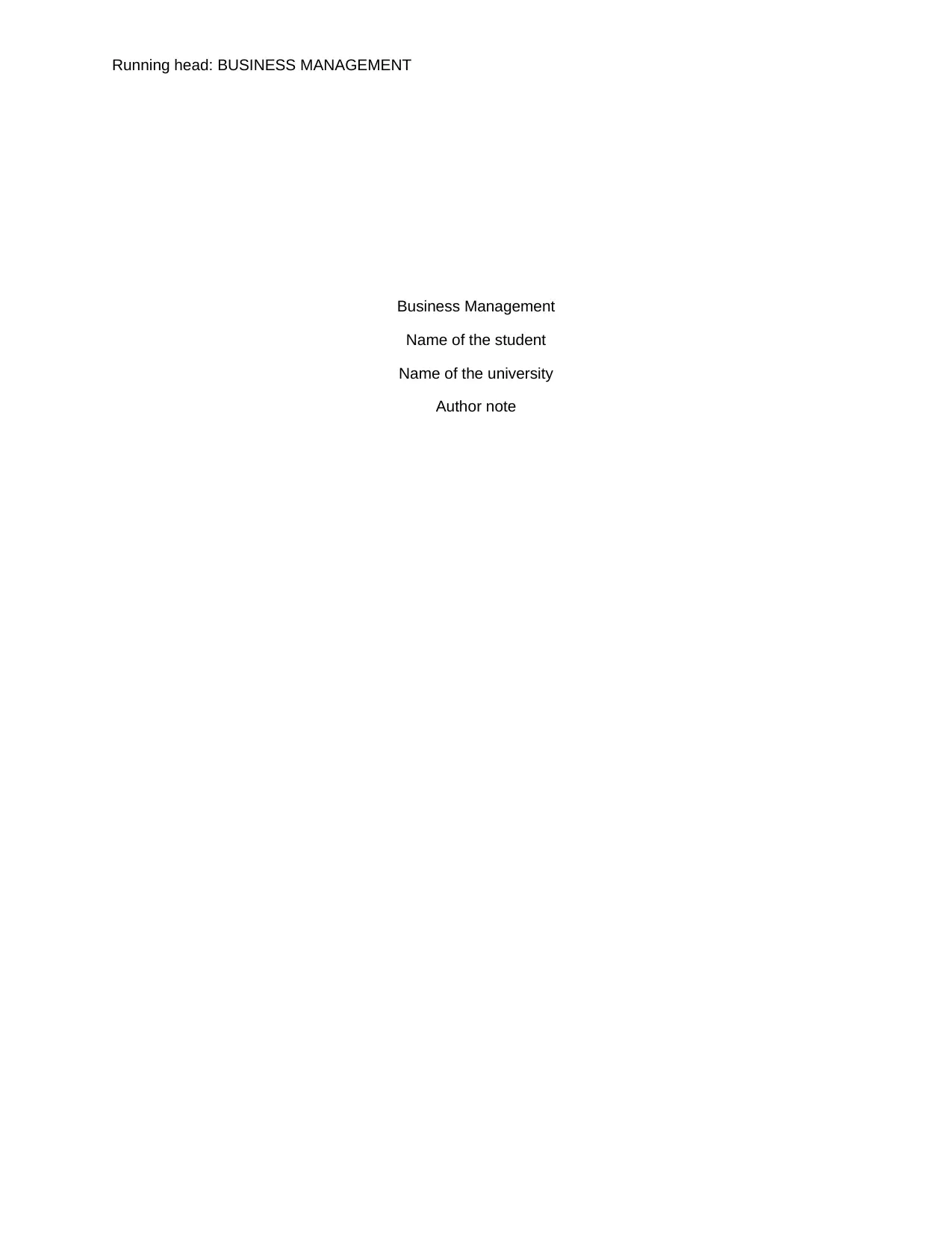
Running head: BUSINESS MANAGEMENT
Business Management
Name of the student
Name of the university
Author note
Business Management
Name of the student
Name of the university
Author note
Paraphrase This Document
Need a fresh take? Get an instant paraphrase of this document with our AI Paraphraser
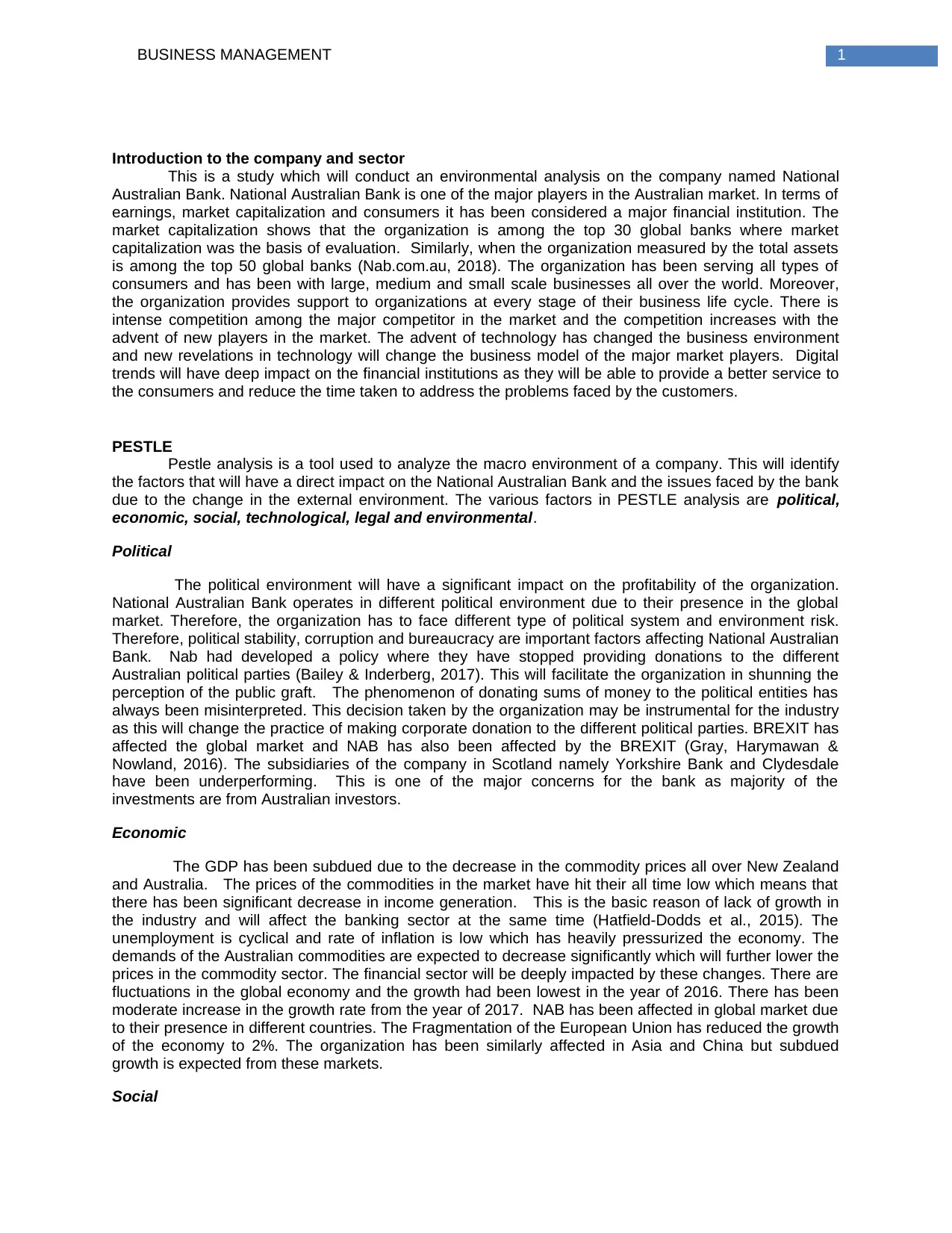
1BUSINESS MANAGEMENT
Introduction to the company and sector
This is a study which will conduct an environmental analysis on the company named National
Australian Bank. National Australian Bank is one of the major players in the Australian market. In terms of
earnings, market capitalization and consumers it has been considered a major financial institution. The
market capitalization shows that the organization is among the top 30 global banks where market
capitalization was the basis of evaluation. Similarly, when the organization measured by the total assets
is among the top 50 global banks (Nab.com.au, 2018). The organization has been serving all types of
consumers and has been with large, medium and small scale businesses all over the world. Moreover,
the organization provides support to organizations at every stage of their business life cycle. There is
intense competition among the major competitor in the market and the competition increases with the
advent of new players in the market. The advent of technology has changed the business environment
and new revelations in technology will change the business model of the major market players. Digital
trends will have deep impact on the financial institutions as they will be able to provide a better service to
the consumers and reduce the time taken to address the problems faced by the customers.
PESTLE
Pestle analysis is a tool used to analyze the macro environment of a company. This will identify
the factors that will have a direct impact on the National Australian Bank and the issues faced by the bank
due to the change in the external environment. The various factors in PESTLE analysis are political,
economic, social, technological, legal and environmental.
Political
The political environment will have a significant impact on the profitability of the organization.
National Australian Bank operates in different political environment due to their presence in the global
market. Therefore, the organization has to face different type of political system and environment risk.
Therefore, political stability, corruption and bureaucracy are important factors affecting National Australian
Bank. Nab had developed a policy where they have stopped providing donations to the different
Australian political parties (Bailey & Inderberg, 2017). This will facilitate the organization in shunning the
perception of the public graft. The phenomenon of donating sums of money to the political entities has
always been misinterpreted. This decision taken by the organization may be instrumental for the industry
as this will change the practice of making corporate donation to the different political parties. BREXIT has
affected the global market and NAB has also been affected by the BREXIT (Gray, Harymawan &
Nowland, 2016). The subsidiaries of the company in Scotland namely Yorkshire Bank and Clydesdale
have been underperforming. This is one of the major concerns for the bank as majority of the
investments are from Australian investors.
Economic
The GDP has been subdued due to the decrease in the commodity prices all over New Zealand
and Australia. The prices of the commodities in the market have hit their all time low which means that
there has been significant decrease in income generation. This is the basic reason of lack of growth in
the industry and will affect the banking sector at the same time (Hatfield-Dodds et al., 2015). The
unemployment is cyclical and rate of inflation is low which has heavily pressurized the economy. The
demands of the Australian commodities are expected to decrease significantly which will further lower the
prices in the commodity sector. The financial sector will be deeply impacted by these changes. There are
fluctuations in the global economy and the growth had been lowest in the year of 2016. There has been
moderate increase in the growth rate from the year of 2017. NAB has been affected in global market due
to their presence in different countries. The Fragmentation of the European Union has reduced the growth
of the economy to 2%. The organization has been similarly affected in Asia and China but subdued
growth is expected from these markets.
Social
Introduction to the company and sector
This is a study which will conduct an environmental analysis on the company named National
Australian Bank. National Australian Bank is one of the major players in the Australian market. In terms of
earnings, market capitalization and consumers it has been considered a major financial institution. The
market capitalization shows that the organization is among the top 30 global banks where market
capitalization was the basis of evaluation. Similarly, when the organization measured by the total assets
is among the top 50 global banks (Nab.com.au, 2018). The organization has been serving all types of
consumers and has been with large, medium and small scale businesses all over the world. Moreover,
the organization provides support to organizations at every stage of their business life cycle. There is
intense competition among the major competitor in the market and the competition increases with the
advent of new players in the market. The advent of technology has changed the business environment
and new revelations in technology will change the business model of the major market players. Digital
trends will have deep impact on the financial institutions as they will be able to provide a better service to
the consumers and reduce the time taken to address the problems faced by the customers.
PESTLE
Pestle analysis is a tool used to analyze the macro environment of a company. This will identify
the factors that will have a direct impact on the National Australian Bank and the issues faced by the bank
due to the change in the external environment. The various factors in PESTLE analysis are political,
economic, social, technological, legal and environmental.
Political
The political environment will have a significant impact on the profitability of the organization.
National Australian Bank operates in different political environment due to their presence in the global
market. Therefore, the organization has to face different type of political system and environment risk.
Therefore, political stability, corruption and bureaucracy are important factors affecting National Australian
Bank. Nab had developed a policy where they have stopped providing donations to the different
Australian political parties (Bailey & Inderberg, 2017). This will facilitate the organization in shunning the
perception of the public graft. The phenomenon of donating sums of money to the political entities has
always been misinterpreted. This decision taken by the organization may be instrumental for the industry
as this will change the practice of making corporate donation to the different political parties. BREXIT has
affected the global market and NAB has also been affected by the BREXIT (Gray, Harymawan &
Nowland, 2016). The subsidiaries of the company in Scotland namely Yorkshire Bank and Clydesdale
have been underperforming. This is one of the major concerns for the bank as majority of the
investments are from Australian investors.
Economic
The GDP has been subdued due to the decrease in the commodity prices all over New Zealand
and Australia. The prices of the commodities in the market have hit their all time low which means that
there has been significant decrease in income generation. This is the basic reason of lack of growth in
the industry and will affect the banking sector at the same time (Hatfield-Dodds et al., 2015). The
unemployment is cyclical and rate of inflation is low which has heavily pressurized the economy. The
demands of the Australian commodities are expected to decrease significantly which will further lower the
prices in the commodity sector. The financial sector will be deeply impacted by these changes. There are
fluctuations in the global economy and the growth had been lowest in the year of 2016. There has been
moderate increase in the growth rate from the year of 2017. NAB has been affected in global market due
to their presence in different countries. The Fragmentation of the European Union has reduced the growth
of the economy to 2%. The organization has been similarly affected in Asia and China but subdued
growth is expected from these markets.
Social
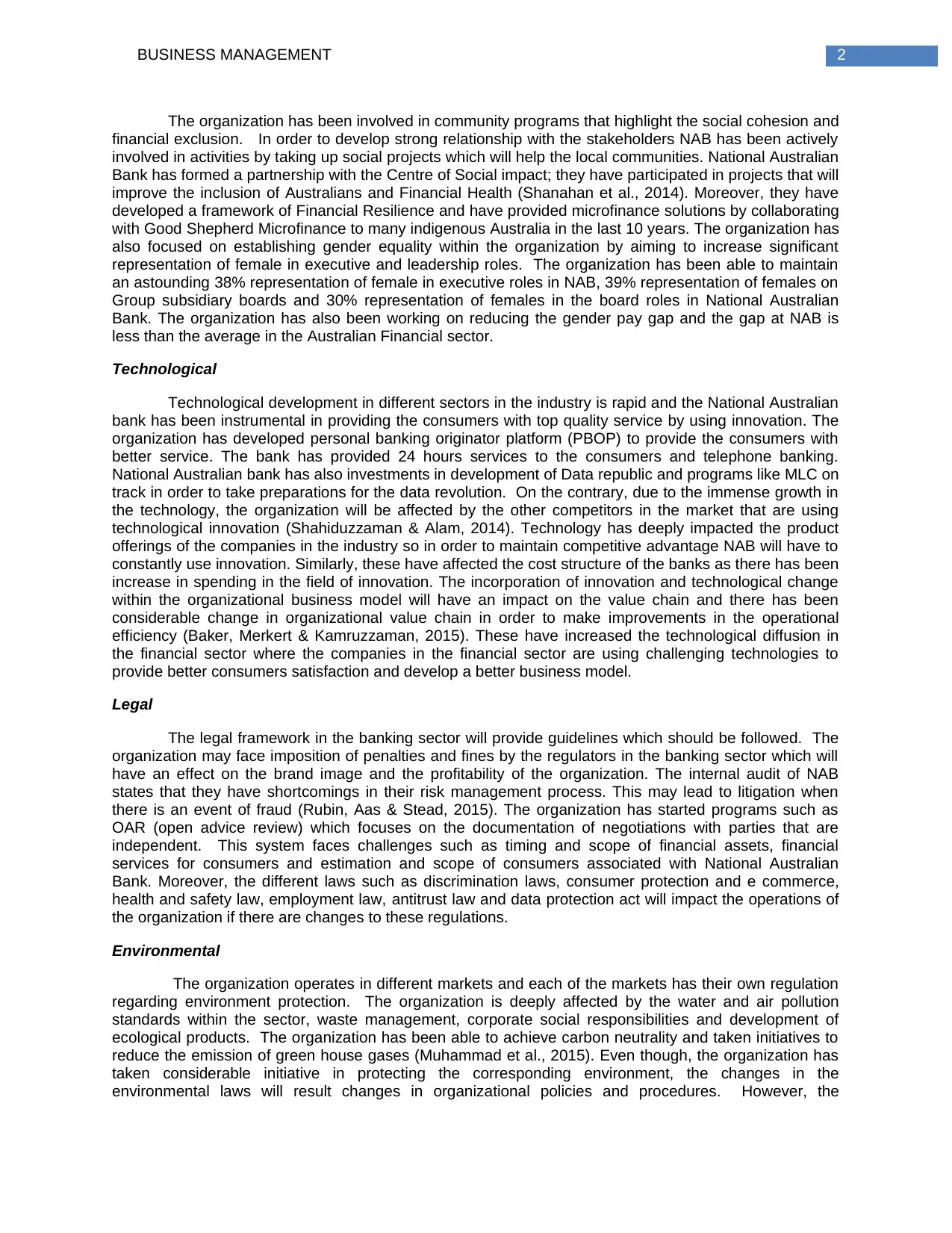
2BUSINESS MANAGEMENT
The organization has been involved in community programs that highlight the social cohesion and
financial exclusion. In order to develop strong relationship with the stakeholders NAB has been actively
involved in activities by taking up social projects which will help the local communities. National Australian
Bank has formed a partnership with the Centre of Social impact; they have participated in projects that will
improve the inclusion of Australians and Financial Health (Shanahan et al., 2014). Moreover, they have
developed a framework of Financial Resilience and have provided microfinance solutions by collaborating
with Good Shepherd Microfinance to many indigenous Australia in the last 10 years. The organization has
also focused on establishing gender equality within the organization by aiming to increase significant
representation of female in executive and leadership roles. The organization has been able to maintain
an astounding 38% representation of female in executive roles in NAB, 39% representation of females on
Group subsidiary boards and 30% representation of females in the board roles in National Australian
Bank. The organization has also been working on reducing the gender pay gap and the gap at NAB is
less than the average in the Australian Financial sector.
Technological
Technological development in different sectors in the industry is rapid and the National Australian
bank has been instrumental in providing the consumers with top quality service by using innovation. The
organization has developed personal banking originator platform (PBOP) to provide the consumers with
better service. The bank has provided 24 hours services to the consumers and telephone banking.
National Australian bank has also investments in development of Data republic and programs like MLC on
track in order to take preparations for the data revolution. On the contrary, due to the immense growth in
the technology, the organization will be affected by the other competitors in the market that are using
technological innovation (Shahiduzzaman & Alam, 2014). Technology has deeply impacted the product
offerings of the companies in the industry so in order to maintain competitive advantage NAB will have to
constantly use innovation. Similarly, these have affected the cost structure of the banks as there has been
increase in spending in the field of innovation. The incorporation of innovation and technological change
within the organizational business model will have an impact on the value chain and there has been
considerable change in organizational value chain in order to make improvements in the operational
efficiency (Baker, Merkert & Kamruzzaman, 2015). These have increased the technological diffusion in
the financial sector where the companies in the financial sector are using challenging technologies to
provide better consumers satisfaction and develop a better business model.
Legal
The legal framework in the banking sector will provide guidelines which should be followed. The
organization may face imposition of penalties and fines by the regulators in the banking sector which will
have an effect on the brand image and the profitability of the organization. The internal audit of NAB
states that they have shortcomings in their risk management process. This may lead to litigation when
there is an event of fraud (Rubin, Aas & Stead, 2015). The organization has started programs such as
OAR (open advice review) which focuses on the documentation of negotiations with parties that are
independent. This system faces challenges such as timing and scope of financial assets, financial
services for consumers and estimation and scope of consumers associated with National Australian
Bank. Moreover, the different laws such as discrimination laws, consumer protection and e commerce,
health and safety law, employment law, antitrust law and data protection act will impact the operations of
the organization if there are changes to these regulations.
Environmental
The organization operates in different markets and each of the markets has their own regulation
regarding environment protection. The organization is deeply affected by the water and air pollution
standards within the sector, waste management, corporate social responsibilities and development of
ecological products. The organization has been able to achieve carbon neutrality and taken initiatives to
reduce the emission of green house gases (Muhammad et al., 2015). Even though, the organization has
taken considerable initiative in protecting the corresponding environment, the changes in the
environmental laws will result changes in organizational policies and procedures. However, the
The organization has been involved in community programs that highlight the social cohesion and
financial exclusion. In order to develop strong relationship with the stakeholders NAB has been actively
involved in activities by taking up social projects which will help the local communities. National Australian
Bank has formed a partnership with the Centre of Social impact; they have participated in projects that will
improve the inclusion of Australians and Financial Health (Shanahan et al., 2014). Moreover, they have
developed a framework of Financial Resilience and have provided microfinance solutions by collaborating
with Good Shepherd Microfinance to many indigenous Australia in the last 10 years. The organization has
also focused on establishing gender equality within the organization by aiming to increase significant
representation of female in executive and leadership roles. The organization has been able to maintain
an astounding 38% representation of female in executive roles in NAB, 39% representation of females on
Group subsidiary boards and 30% representation of females in the board roles in National Australian
Bank. The organization has also been working on reducing the gender pay gap and the gap at NAB is
less than the average in the Australian Financial sector.
Technological
Technological development in different sectors in the industry is rapid and the National Australian
bank has been instrumental in providing the consumers with top quality service by using innovation. The
organization has developed personal banking originator platform (PBOP) to provide the consumers with
better service. The bank has provided 24 hours services to the consumers and telephone banking.
National Australian bank has also investments in development of Data republic and programs like MLC on
track in order to take preparations for the data revolution. On the contrary, due to the immense growth in
the technology, the organization will be affected by the other competitors in the market that are using
technological innovation (Shahiduzzaman & Alam, 2014). Technology has deeply impacted the product
offerings of the companies in the industry so in order to maintain competitive advantage NAB will have to
constantly use innovation. Similarly, these have affected the cost structure of the banks as there has been
increase in spending in the field of innovation. The incorporation of innovation and technological change
within the organizational business model will have an impact on the value chain and there has been
considerable change in organizational value chain in order to make improvements in the operational
efficiency (Baker, Merkert & Kamruzzaman, 2015). These have increased the technological diffusion in
the financial sector where the companies in the financial sector are using challenging technologies to
provide better consumers satisfaction and develop a better business model.
Legal
The legal framework in the banking sector will provide guidelines which should be followed. The
organization may face imposition of penalties and fines by the regulators in the banking sector which will
have an effect on the brand image and the profitability of the organization. The internal audit of NAB
states that they have shortcomings in their risk management process. This may lead to litigation when
there is an event of fraud (Rubin, Aas & Stead, 2015). The organization has started programs such as
OAR (open advice review) which focuses on the documentation of negotiations with parties that are
independent. This system faces challenges such as timing and scope of financial assets, financial
services for consumers and estimation and scope of consumers associated with National Australian
Bank. Moreover, the different laws such as discrimination laws, consumer protection and e commerce,
health and safety law, employment law, antitrust law and data protection act will impact the operations of
the organization if there are changes to these regulations.
Environmental
The organization operates in different markets and each of the markets has their own regulation
regarding environment protection. The organization is deeply affected by the water and air pollution
standards within the sector, waste management, corporate social responsibilities and development of
ecological products. The organization has been able to achieve carbon neutrality and taken initiatives to
reduce the emission of green house gases (Muhammad et al., 2015). Even though, the organization has
taken considerable initiative in protecting the corresponding environment, the changes in the
environmental laws will result changes in organizational policies and procedures. However, the
⊘ This is a preview!⊘
Do you want full access?
Subscribe today to unlock all pages.

Trusted by 1+ million students worldwide
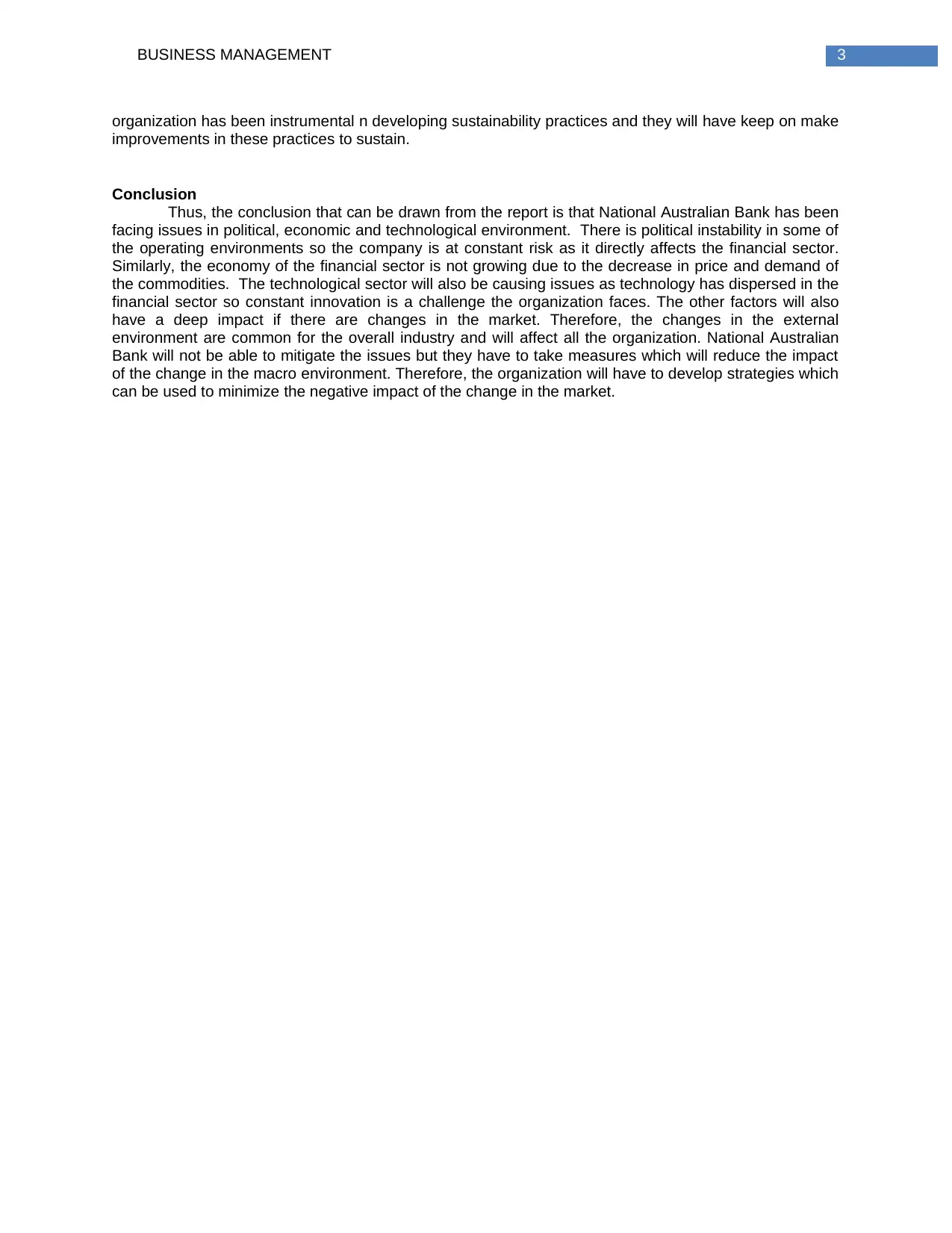
3BUSINESS MANAGEMENT
organization has been instrumental n developing sustainability practices and they will have keep on make
improvements in these practices to sustain.
Conclusion
Thus, the conclusion that can be drawn from the report is that National Australian Bank has been
facing issues in political, economic and technological environment. There is political instability in some of
the operating environments so the company is at constant risk as it directly affects the financial sector.
Similarly, the economy of the financial sector is not growing due to the decrease in price and demand of
the commodities. The technological sector will also be causing issues as technology has dispersed in the
financial sector so constant innovation is a challenge the organization faces. The other factors will also
have a deep impact if there are changes in the market. Therefore, the changes in the external
environment are common for the overall industry and will affect all the organization. National Australian
Bank will not be able to mitigate the issues but they have to take measures which will reduce the impact
of the change in the macro environment. Therefore, the organization will have to develop strategies which
can be used to minimize the negative impact of the change in the market.
organization has been instrumental n developing sustainability practices and they will have keep on make
improvements in these practices to sustain.
Conclusion
Thus, the conclusion that can be drawn from the report is that National Australian Bank has been
facing issues in political, economic and technological environment. There is political instability in some of
the operating environments so the company is at constant risk as it directly affects the financial sector.
Similarly, the economy of the financial sector is not growing due to the decrease in price and demand of
the commodities. The technological sector will also be causing issues as technology has dispersed in the
financial sector so constant innovation is a challenge the organization faces. The other factors will also
have a deep impact if there are changes in the market. Therefore, the changes in the external
environment are common for the overall industry and will affect all the organization. National Australian
Bank will not be able to mitigate the issues but they have to take measures which will reduce the impact
of the change in the macro environment. Therefore, the organization will have to develop strategies which
can be used to minimize the negative impact of the change in the market.
Paraphrase This Document
Need a fresh take? Get an instant paraphrase of this document with our AI Paraphraser
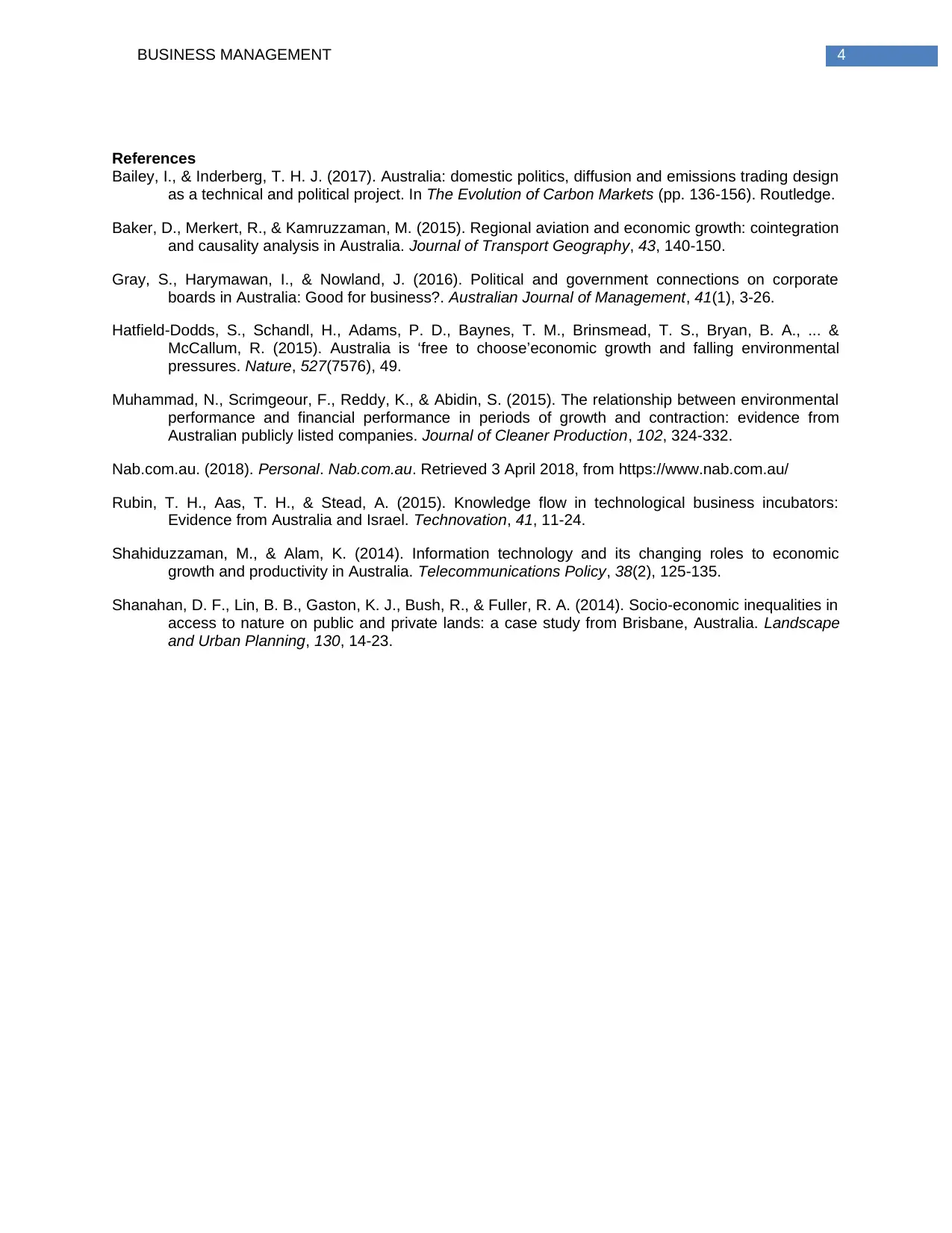
4BUSINESS MANAGEMENT
References
Bailey, I., & Inderberg, T. H. J. (2017). Australia: domestic politics, diffusion and emissions trading design
as a technical and political project. In The Evolution of Carbon Markets (pp. 136-156). Routledge.
Baker, D., Merkert, R., & Kamruzzaman, M. (2015). Regional aviation and economic growth: cointegration
and causality analysis in Australia. Journal of Transport Geography, 43, 140-150.
Gray, S., Harymawan, I., & Nowland, J. (2016). Political and government connections on corporate
boards in Australia: Good for business?. Australian Journal of Management, 41(1), 3-26.
Hatfield-Dodds, S., Schandl, H., Adams, P. D., Baynes, T. M., Brinsmead, T. S., Bryan, B. A., ... &
McCallum, R. (2015). Australia is ‘free to choose’economic growth and falling environmental
pressures. Nature, 527(7576), 49.
Muhammad, N., Scrimgeour, F., Reddy, K., & Abidin, S. (2015). The relationship between environmental
performance and financial performance in periods of growth and contraction: evidence from
Australian publicly listed companies. Journal of Cleaner Production, 102, 324-332.
Nab.com.au. (2018). Personal. Nab.com.au. Retrieved 3 April 2018, from https://www.nab.com.au/
Rubin, T. H., Aas, T. H., & Stead, A. (2015). Knowledge flow in technological business incubators:
Evidence from Australia and Israel. Technovation, 41, 11-24.
Shahiduzzaman, M., & Alam, K. (2014). Information technology and its changing roles to economic
growth and productivity in Australia. Telecommunications Policy, 38(2), 125-135.
Shanahan, D. F., Lin, B. B., Gaston, K. J., Bush, R., & Fuller, R. A. (2014). Socio-economic inequalities in
access to nature on public and private lands: a case study from Brisbane, Australia. Landscape
and Urban Planning, 130, 14-23.
References
Bailey, I., & Inderberg, T. H. J. (2017). Australia: domestic politics, diffusion and emissions trading design
as a technical and political project. In The Evolution of Carbon Markets (pp. 136-156). Routledge.
Baker, D., Merkert, R., & Kamruzzaman, M. (2015). Regional aviation and economic growth: cointegration
and causality analysis in Australia. Journal of Transport Geography, 43, 140-150.
Gray, S., Harymawan, I., & Nowland, J. (2016). Political and government connections on corporate
boards in Australia: Good for business?. Australian Journal of Management, 41(1), 3-26.
Hatfield-Dodds, S., Schandl, H., Adams, P. D., Baynes, T. M., Brinsmead, T. S., Bryan, B. A., ... &
McCallum, R. (2015). Australia is ‘free to choose’economic growth and falling environmental
pressures. Nature, 527(7576), 49.
Muhammad, N., Scrimgeour, F., Reddy, K., & Abidin, S. (2015). The relationship between environmental
performance and financial performance in periods of growth and contraction: evidence from
Australian publicly listed companies. Journal of Cleaner Production, 102, 324-332.
Nab.com.au. (2018). Personal. Nab.com.au. Retrieved 3 April 2018, from https://www.nab.com.au/
Rubin, T. H., Aas, T. H., & Stead, A. (2015). Knowledge flow in technological business incubators:
Evidence from Australia and Israel. Technovation, 41, 11-24.
Shahiduzzaman, M., & Alam, K. (2014). Information technology and its changing roles to economic
growth and productivity in Australia. Telecommunications Policy, 38(2), 125-135.
Shanahan, D. F., Lin, B. B., Gaston, K. J., Bush, R., & Fuller, R. A. (2014). Socio-economic inequalities in
access to nature on public and private lands: a case study from Brisbane, Australia. Landscape
and Urban Planning, 130, 14-23.
1 out of 5
Related Documents
Your All-in-One AI-Powered Toolkit for Academic Success.
+13062052269
info@desklib.com
Available 24*7 on WhatsApp / Email
![[object Object]](/_next/static/media/star-bottom.7253800d.svg)
Unlock your academic potential
Copyright © 2020–2025 A2Z Services. All Rights Reserved. Developed and managed by ZUCOL.





